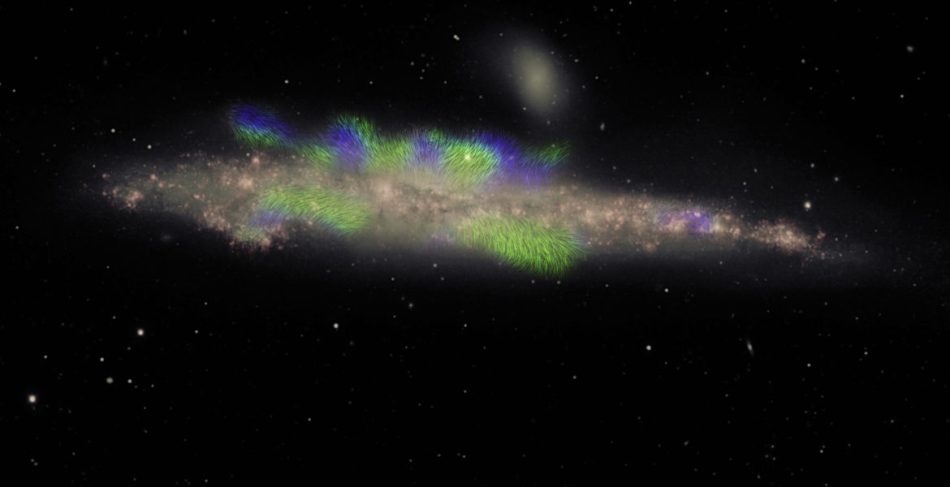Nov 27 2019
The National Science Foundation’s Karl G. Jansky Very Large Array (VLA) has made an image of the “Whale Galaxy” (NGC 4631), which exposes hair-like filaments of the galaxy’s magnetic field extending above and below the disk of the galaxy.
 The observations are part of the project Continuum HAlos in Nearby Galaxies—an EVLA Survey (CHANG-ES). The optical data were from the Mayall 4-m telescope, collected by Maria Patterson and Rene Walterbos of New Mexico State University. Arpad Miskolczi of the University of Bochum provided the software code for tracing the magnetic field lines. Image Credit: Composite image by Jayanne English of the University of Manitoba, with NRAO VLA radio data from Silvia Carolina Mora-Partiarroyo and Marita Krause of the Max-Planck Institute for Radioastronomy.
The observations are part of the project Continuum HAlos in Nearby Galaxies—an EVLA Survey (CHANG-ES). The optical data were from the Mayall 4-m telescope, collected by Maria Patterson and Rene Walterbos of New Mexico State University. Arpad Miskolczi of the University of Bochum provided the software code for tracing the magnetic field lines. Image Credit: Composite image by Jayanne English of the University of Manitoba, with NRAO VLA radio data from Silvia Carolina Mora-Partiarroyo and Marita Krause of the Max-Planck Institute for Radioastronomy.
The spiral galaxy can be seen edge-on, with its disk of stars presented in pink. The filaments, shown in green and blue, spread beyond the disk into the extended halo of the galaxy. Green specifies filaments with their magnetic field facing approximately toward the Earth and blue with the field facing away. This spectacle, with the field alternating in direction, has not been witnessed before in the halo of a galaxy.
This is the first time that we have clearly detected what astronomers call large-scale, coherent, magnetic fields far in the halo of a spiral galaxy, with the field lines aligned in the same direction over distances of a thousand light-years. We even see a regular pattern of this organized field changing direction.
Marita Krause, Researcher, Max-Planck Institute for Radioastronomy
According to an international team of astronomers, forming part of a project known as the Continuum HAlos in Nearby Galaxies—an EVLA Survey (CHANG-ES), led by Judith Irwin of Queen’s University in Ontario, the image shows a large-scale, coherent magnetic field that is produced by dynamo action inside the galaxy and spirals far beyond in the form of giant magnetic ropes perpendicular to the disk.
We are a little bit like the blind men and the elephant, since each time we look at the galaxy in a different way we reach a different conclusion about its nature! However, we seem to have one of those rare occasions where a classical theory, about magnetic generators called dynamos, predicted the observations of NGC 4631 quite well.
Richard Henriksen, Researcher, Queen’s University
Henriksen continued, “Our dynamo model produces spiralling magnetic fields in the halo that are a continuation of the normal spiral arms in the galaxy’s disc.”
The researchers continue their efforts to further improve their knowledge about the galaxy’s complete magnetic structure.
The image was formed by integrating data from several observations with the VLA’s giant dish antennas set in various configurations to illustrate both large structures and finer details inside the galaxy. The radio waves naturally emitted from the galaxy were examined to unravel the magnetic fields, as well as their directions.
According to the researchers, the methods used to establish the direction of the magnetic field lines, shown by this image, can be applied to this and other galaxies to resolve crucial questions regarding whether coherent magnetic fields are widely present in galactic halos and what their shapes are.
They said that developing such an image can provide solutions to major questions such as how galaxies obtain magnetic fields, and if all such fields are created by a dynamo effect. Can these galaxy halo fields reveal the mysterious source of the even larger intergalactic magnetic fields that have been witnessed?
NGC 4631—located in the constellation Canes Venatici, 25 million light-years from Earth—measures around 80,000 light-years across, somewhat smaller than the Milky Way. It was discovered in 1787 by the renowned British astronomer Sir William Herschel. This image also reveals a companion, NGC 4627, a small elliptical galaxy, right above NGC 4631.
The results of the research were published in the journal Astronomy & Astrophysics.